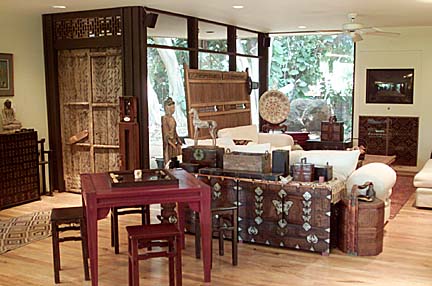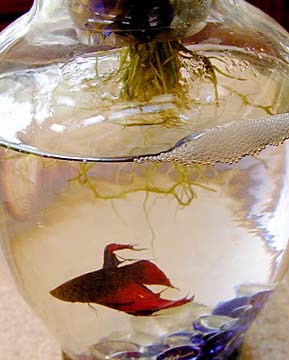


In The Garden![]()
Friday, August 3, 2001

CRAIG T. KOJIMA / CKOJIMA@STARBULLETIN.COM
The Waianae mountain range forms a backdrop
to a field of lotus blossoms at the Haleiwa home
of Dorothea and Kaya Ogdemli.
Count your blessings if you are among the lucky few who have been allowed a visit to Dorothea and Kaya Ogdemli's lotus ponds when the Lotus imperialis are in peak bloom. Every year about May, the muddy ponds in Haleiwa become a solid sea of giant, bright pink flowers that unfold at the tips of 10-foot-high stalks. Hidden lotus ponds
of HaleiwaA sea of pink erupts
each year at the Ogdemlis'Last year there were 2,000 blossoms in the one-third-acre ponds, and the Ogdemlis expect at least that many this year. It all began with seven shriveled and moldy lotus tubers that a friend brought back from China.
"We just thought we put them in the ponds and try it. (A year following the planting) we had 470 blossoms; and the next year, we had 1,500 blossoms. Then the next year we had almost 2,000," Dorothea Ogdemli said.

By this time of the year, the peak blooming period is coming to a close although there are perhaps 100 to 200 blooms remaining, which still add up to an impressive sight. The flowers are a vibrant pink the first day. They fade to a lighter pink on the second day, and by the third day, the flowers turn to a pure white with pink edging and vains.In about a couple of months, all the flowers will be gone, each becoming a "shower head" seed pod bearing tasty and highly sought-after lotus seeds.
The Ogdemlis do not sell the delicacy. They will cut down the seed pods at the end of the year and give them away to friends -- presumably the same lucky ones who get to see the beautiful but hidden water garden at its peak.

Actually water garden isn't quite accurate in describing the Ogdemli's 6-year-old gardening endeavor. Their lotus garden design is reminiscent of the picturesque lotus farms in Asia -- big ponds covered end to end with plants harvested for the edible seeds, leaves and roots.And just as in Asia, where water fowl make their homes near lotus ponds, the Ogdemlis also have added flocks of geese and ducks. Again, they do not rear the birds for commercial purposes; the creatures merely add a romantic, picturesque element to the scenery.
"Everything is for our own enjoyment ... the lotus, the geese, the ducks. We do it because we like it," Dorothea Ogdemli said.
The Ogdemlis are really city folks who have opted for a rustic lifestyle in their retirement. She was a professional photographer and proprietor of a successful Asian art-and-antiques store, Treasures of the East, on Makaloa Street. He was an architect and builder of manufacturing factories, and also co-owner of the antique store.

They met and married in Thailand 30 years ago, and a consulting assignment for Pan American Airlines brought them to Honolulu 28 years ago. They retired after closing Treasures of the East about 10 years ago and settled at their Haleiwa home.The property includes a modern-style house that needed serious repair, old majestic trees, and lots and lots of weeds. The weeds were so thick and tall that the Ogdemlis did not realize they had four dried-out taro ponds on their property until they did some research.
"The ponds were totally overgrown with California grass. You couldn't see anything. It was all wild. It took a year and a lot of hard work to clear it out," Dorothea Ogdemli said.
With their son's help, the couple revived the ponds, clearing the weeds and feeding a mountain stream into the ponds. At first, they planted ornamental water lillies, but they died out once the much larger lotus plants took hold.
The lotus ponds are the only part of their property that is finished; the rest still is a work in progress, they said. The couple does the work mostly themselves beginning at 5:30 a.m. every day -- she mostly tending to the garden while he mostly works on the house, although he says "she is the boss" in and out of the house.

Kaya Ogdemli has refurbished the large two-bedroom home with mango-wood floors, koa wood kitchen cabinets, a Venetian glass-tile bath, numerous sky lights (including a dome-shaped one with a moveable insulator hood) and other handmade features.He also has extended his carpentry and design skills to include building furniture for their home. One of the show pieces is a set of six interlocking tables made of purple heart wood inlaid with ebony.
"He does beautiful work, but he works only for me," Dorothea Ogdemli said, adding that she has plenty projects waiting for him.
They want a house furnished with special things -- Asian art and antiques for which they have a special fondness, or pieces from their childhood and Kaya's workshop. They also want their home to be filled with living things like plants and animals. (On the kitchen center island, a Siamese fighting fish shares a vase with a miniature spathiphyllum.)
The couple has a horse (Cody); a part retriever (Sam), who loves to frolic in the lotus ponds; and a cat (Dum, which means "blackened" in Thai). And, for the record, there are 18 geese and 20 ducks at last count, plus some chickens with numerous chicks. The water fowl help themselves to the crayfish living in the lotus ponds, and all the animals -- except the horse, which has its own large fenced area -- roam freely on the property.
Orchids and bromeliads dot the landscape, as do Asian artifacts. A large tool shed is decorated on the outside with carved wood pieces gathered throughout Asia.
While the property is not yet a finished work of art, it has garnered admirers through word of mouth. Artists have come to paint the lotus blossoms, photographers have come to record the site's rare beauty, lovebirds have had their weddings in the garden, gardeners have gathered for educational tours. The garden was open for a fund-raiser once but the visitors always were limited to a manageable number.
The Ogdemlis wish for privacy and do not open their property to the public. But if you are lucky enough to know somebody who can get in, and if you ask very nicely, you might be able to get your foot in the gate.
But you'll have to be patient. The lotus blooms for three months once a year, and the best time for the blossoms won't be until next May.
Gardening Calendar
Suzanne Tswei's gardening column runs Saturdays in Today.
You can write her at the Star-Bulletin,
500 Ala Moana, Suite 7-210, Honolulu, HI, 96813
or email stswei@starbulletin.com